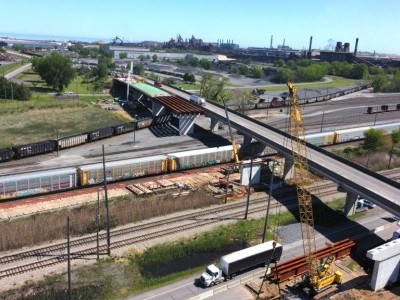Port of Hamburg: Sustained growth in hinterland transports
Nov 15, 2024At 5.8 million TEU, container throughput at the Port of Hamburg remained at almost the same level year-on-year during the first nine months of 2024. Throughput of loaded containers saw slight growth, alongside an increase in general cargo. “Rail forwarding, a cornerstone of sustainable transport, also developed positively in the first nine months. As Europe’s largest rail port, we attach great importance to the expansion of rail transport. Container transport in this segment rose by 2.7 percent and the Port of Hamburg also gained ground in terms of total rail tonnage”, says Axel Mattern, Member of the Executive Board of Port of Hamburg Marketing (HHM).
However, the weak German economy continues to impact total throughput at the port. The tense political circumstances with the war in Ukraine and the attacks by Houthi militias in the Red Sea merely exacerbate this situation. Total seaborne cargo throughput fell by 3.0 percent and stood at 84.0 million tonnes in the period from January to September 2024.
Varying status of container throughput
At 5.1 million TEU, loaded container throughput grew by 0.2 percent in a year-on-year comparison. By contrast, throughput of empty containers slumped by 4.6 percent to 722,000 TEU. Overall container throughput was 5.8 million TEU (-0.4 percent). Container throughput by tonnes – 58.2 million or -0.1 percent – therefore reached almost the same level as in the previous year. A larger number of western ports were used as transhipment hubs for Asia-Mediterranean volumes due to the temporary rerouting of vessels around the Cape of Good Hope. Hamburg did not benefit from this positive effect in container throughput.
The conventional general cargo segment again offered a silver lining. With its considerable potential for value-added, this segment grew by 3.7 percent to 904,000 tonnes.
Bulk goods continue to show mixed trends
Throughput of bulk cargo at the Port of Hamburg experienced a slight recovery over the course of the year. It stood at 24.9 million tonnes (-9.3 percent) after the first nine months. The decline had been 12.1 percent at the halfway point in the year. The drop in coal throughput resulting from the shutdown of some power plants remained a noticeable factor. Throughput of grab cargo amounted to 13.5 million tonnes overall (-7.7 percent).
For suction cargo or agribulk, with a throughput of 4.8 million tonnes (-4.1 percent), the export of animal feed stood out positively with 1.0 million tonnes and an increase of 7.8 percent. Imports of oilseeds also improved by 2.8 percent to 2.3 million tonnes. Liquid cargo throughput dropped by 15.6 percent to 6.6 million tonnes, despite a 34.6 percent surge in petroleum product exports, which reached 1.3 million tonnes.
Stable ranking of trade partners
Accounting for throughput of 1.6 million TEU, China has remained the strongest partner country in the period from January to September 2024. Trade with the United States is growing as well. The second-strongest partner country recorded an increase of 7.6 percent to 520,000 TEU. Trade with Brazil also rose by 2.6 percent to 124,000 TEU. Registering growth of 3.5 percent and throughput of 81.000 TEU, Mexico was another positive example. In addition, seaborne trade with Poland (4th place) experienced a positive development with an increase of 16.0 percent and a volume of 232,000 TEU. Malaysia (9th place) was another pleasing example with 144,000 TEU and a rise of 29.8 percent.
More vessels calling at Hamburg
Ship calls with capacity for container cargo in the Port of Hamburg were up 0.3 percent year-on-year in the first three quarters of 2024. Moderate and small vessel sizes experienced a positive development here.
Rail features prominently in hinterland transports
Container transport by rail in seaport-hinterland transport grew by 2.7 percent in the first nine months of this year, reaching 2.0 million TEU. Total tonnage reached 35.1 million tonnes, representing a year-on-year growth of 1.4 percent. “These figures underscore the high performance and environmental benefits of rail transport. Despite poor weather conditions, technical challenges and workforce shortages, rail remains on the path to success”, emphasizes Mattern.

Similar Stories

Port of Prince Rupert moved 23.1M tonnes of cargo in 2024 amid historic expansion phase
View Article
Port of Long Beach’s Cordero hails ‘Green Port’ achievements
View Article
Steering the Ship, Jess Ramirez Sworn In as President of Oxnard Harbor District
View Article
Jeffersonville port delivers record road salt shipments to Greater Louisville area during recent winter storms
View ArticleNC Ports Notice: Holiday Schedule Notice Martin Luther King Jr. Day
The Port of Wilmington Container Gate (South Gate) and the Charlotte Inland Port (CIP) will operate on a reduced schedule on Monday, January 20: 8 AM-12 PM and 1 PM-5…
View Article
Port of San Diego accepts $5 million grant from the San Diego County Air Pollution Control District for clean air project
View ArticleGet the most up-to-date trending news!
SubscribeIndustry updates and weekly newsletter direct to your inbox!





